So, you need to write a request for proposal (RFP). But, you’re not quite sure where to start? Well, you’ve come to the right place. The ability to write an RFP is a valuable skill for any professional. Indeed, when done correctly, the RFP process allows you to select the right vendor, ensure competitive pricing and reduce risk.
RFPs are widely used in business and have a long history. Consequently, it’s important to understand the RFP process and best practices to ensure success. A good RFP is as concise as possible while offering helpful contextual information for vendors and asking the right questions. It can be a hard balance to strike.
Fortunately, we’re here to help with everything you need to know about writing an RFP. To start, we’ll offer a summary of RFP basics including the definition of an RFP, what’s included and an overview of the process. Then, I’ll offer five tips for writing effective RFPs. Finally, you’ll get a list of helpful resources to deepen your knowledge including tools and examples to inspire and improve your next RFP.
RFP basics
As you know, RFP documents are commonly used by businesses and organizations who need an objective process for selecting a vendor partner. However, before we jump into how to write an RFP, it’s important to have a foundational understanding of the purpose of an RFP, as well as the typical RFP format and process.
RFP definition
A request for proposal, abbreviated as RFP, is a document created by a buyer and issued to vendors requesting information about the company and their product or service. Essentially, an RFP is a form with questions and space for vendors to write answers.
Discover all of the terms and acronyms common to procurement in this glossary: RFP dictionary
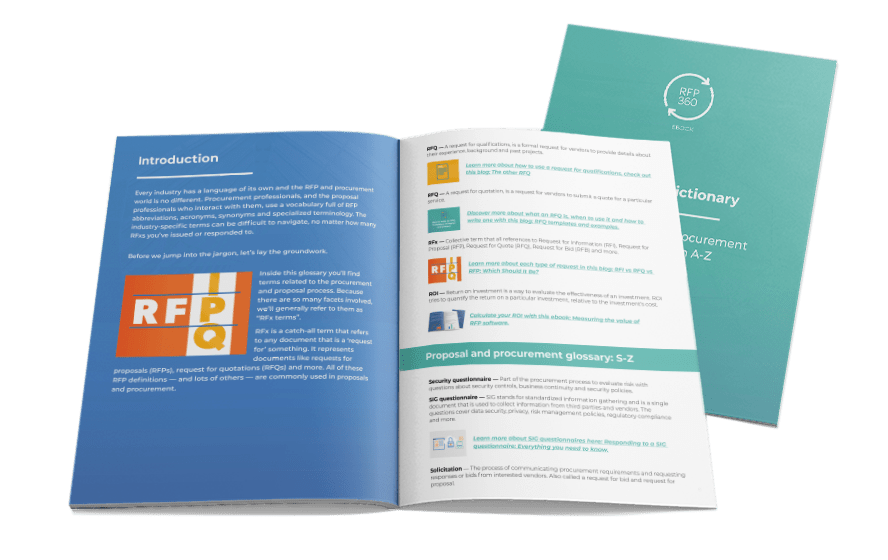
The RFP’s purpose is to allow a buyer to make an unbiased, informed and confident decision. It’s most common for organizations to issue RFPs in Word, Excel or using RFP management software. While there’s no standard format, there are some elements that appear in most RFPs.
What should be in an RFP?
A request for proposal covers a lot of ground. While asking the right questions is an important part of a good RFP, there’s a lot more to it. Indeed, most RFPs start with information about the buyer, the project and process. Below you’ll see an overview of the sections and order of information included in most RFPs.
- High-level overview or summary of needs
- Buyer introduction and background
- Goals and project scope
- Budget
- Minimum vendor requirements
- Evaluation and submission criteria
- RFP timeline
- Scoring process
- RFP sections and question
- Terms and conditions
- Attachments
Of course, not everyone agrees on exactly what should be included in an RFP. If you follow the RFP guide offered by Hubspot, you’ll see a variation on the sections listed above. However, in the video below, Mark Wolters, teaching associate professor at the University of Illinois at Urbana-Champaign, suggests including 12 sections.
The point is that there isn’t a standardized RFP format that you must follow. For those new to RFP issuers, it may feel confusing. However, once familiar with the process, many people come to appreciate the flexibility of the RFP document. Indeed, you can use it to meet your unique needs. For instance, you can issue a very short, simple RFP, sometimes called RFP lite, for lower-value projects. On the other hand, you can create a comprehensive, multi-step RFP for high-value, strategic sourcing projects.
The RFP process
The quality of your RFP has wide-reaching consequences (more on that below). While this post focuses on how to write a request for proposal, it is just one step in the larger RFP process. Just remember, writing the RFP sets the stake for the rest of your process.
According to the RFP process guide ebook, there are six essential steps in the RFP process:
- Gathering RFP requirements
- Crafting your RFP
- Conducting the initial evaluation
- Following up with shortlisted vendors
- Making your final selection
- Creating and completing the contract
For more detail about the steps of the RFP process, download the ebook: The RFP process guide.
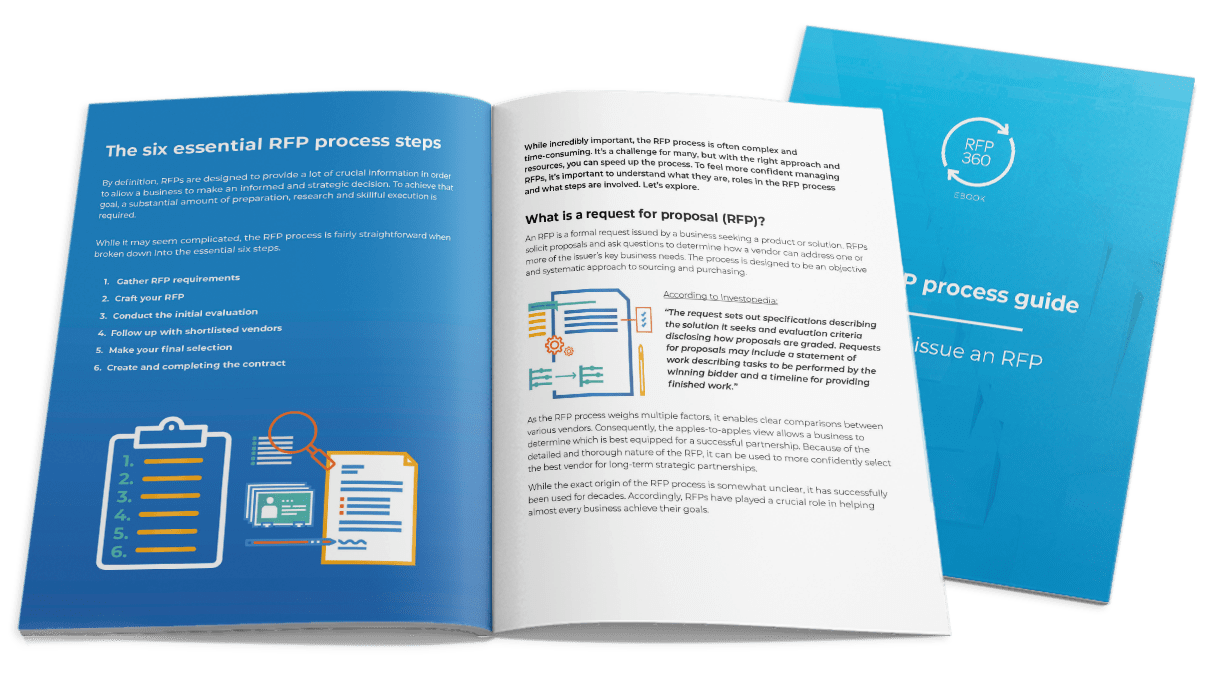
The importance of a well-written RFP
As any vendor or supplier will tell you, there are good RFPs and bad RFPs and it’s obvious which is which. Good RFPs are highly-customized, clear, concise and thoughtful. Consequently, these RFPs tend to receive proposals that are likewise of a high-quality. On the other hand, there are some RFP red flags that may signal to your vendors that the project isn’t worth their time. These poorly written RFPs result in low-quality proposals. Or, worse yet, too few proposals to make a confident decision.
The key to writing an RFP is to strike a balance between too little and too much information. If you offer vendors too little information with a few broad questions, you may get proposals that miss the mark from unqualified vendors. On the other hand, if you offer too much with too many highly-specific questions, vendors may be discouraged from answering your RFP. Remember, examine your specific needs and decide how much detail you need to make the right decision.
5 tips: How to write an RFP that works
Why do some RFPs work and some don’t? It comes down to how they were created. An ineffective RFP is expensive and risky. At best, you waste time and resources. But at worst, you may find yourself stuck in a bad relationship with the wrong vendor. However, with these five tips, you can be sure to write an RFP that will deliver results.
1. Collaborate with stakeholders
Issuing RFPs is about solving problems for your business. Consequently, you need to define and understand the problem to find the best solution. Start by collaborating with the people that are most impacted by the purchase. This process is often called requirements discovery. Together, define the challenge, the tools they need and what success will look like. After all, to draw the right responses from vendors, you have to ask the right questions.
For example, imagine the sales team wants to invest in software. How do you know what questions to ask in the RFP? Typically, in procurement situations like this, there are often team members or technology champions who have independently researched and explored options. Brainstorm with them to categorize functionality as: must have, nice to have or outside of scope.
In addition to discussing priorities with the primary stakeholders, it’s wise to involve IT, finance, legal and any other teams who will be impacted by the procurement decision. Bring these subject matter experts into the process early, before you begin to write the RFP. By doing this, you avoid unnecessary delays and cumbersome back and forth with vendors later in the process.
2. Create a library of standard questions, sections and templates
Every RFP will be a little different. However, many of the questions and sections included will be the same. For instance, details about the evaluation process, customer success questions and terms and conditions will likely be very similar from one RFP to the next.
By curating a library of questions, sections and RFP templates, you can accelerate your process. In addition, maintaining a knowledge library will improve consistency and reduce the risk of issuing an incomplete RFP. RFP software makes this dynamic templating easy. However, you can also build your library manually in Excel or Google Sheets.
There are literally thousands of questions you could ask in your RFP.
Sample RFP questions
- Is there a trial period? If you can sample the solution before making a purchase, you have a much better chance of making the right decision.
- Do you have a change management plan? The company should be invested in your long-term success. That means starting off on the right foot. Will they guide you through the process or throw you to the wolves?
- Can I speak with a current customer? If a vendor doesn’t have references that are willing to speak with you, that’s a red flag. Happy customers are usually willing to voice their support and speak with you directly.
- How do you handle issues? No matter how awesome the product or service a vendor offers, issues happen. Does the vendor have a strong customer success team ready to right any wrongs?
- Who are your competitors? If your vendor isn’t willing to name their competitors, you may need to question their honesty or confidence.
- What are your training options? The better you understand a solution, the more value you can extract from it.
If you’re interested in more examples, here’s a list of 101 of the most common RFP questions. No matter what additional questions you ask, they should reflect your unique circumstances. For instance, you may want to ask questions about your industry challenges and regulations to determine if responders know enough to support your organization.
One additional note: It’s important to focus on asking the right questions at the right time. That means, initially focusing on minimum requirements. Then, moving on to considerations that are deal-breakers. Finally, once you’ve narrowed down your prospective vendors to a short list, asking more run of the mill, standard questions. This structure ensures that unqualified vendors don’t spend tremendous amounts of time in the RFP process only to find out they were never going to be considered.
3. Consider a multi-step process
People often view the RFP document as a catch-all for any time they need information from a vendor, but they actually serve a very specific purpose. Depending on your needs, it may be better to use a multi-step process or to issue a different ‘request for’ process (RFX) altogether. That’s why it’s critical that you understand the difference between the most common vendor information requests.
Each document fulfills a different purpose. However, they are often used in conjunction with one anther.
An overview of various procurement and RFX processes
- RFI — Request for information: Used for information gathering
- RFP — Request for proposal: Gathers detailed, in depth information
- RFQ — Request for qualifications: Used to evaluate vendor qualifications
- RFQ — Request for quotation: Defines exactly what you want and requests the lowest price
- RFO – Request for offer: Asks vendors to provide a creative solution to a problem
- Vendor profile — Used for recurring procurement to catalog vendor qualifications and offerings
For faster RFX selection download this infographic: RFX selection guide: RFI vs RFQ vs RFP
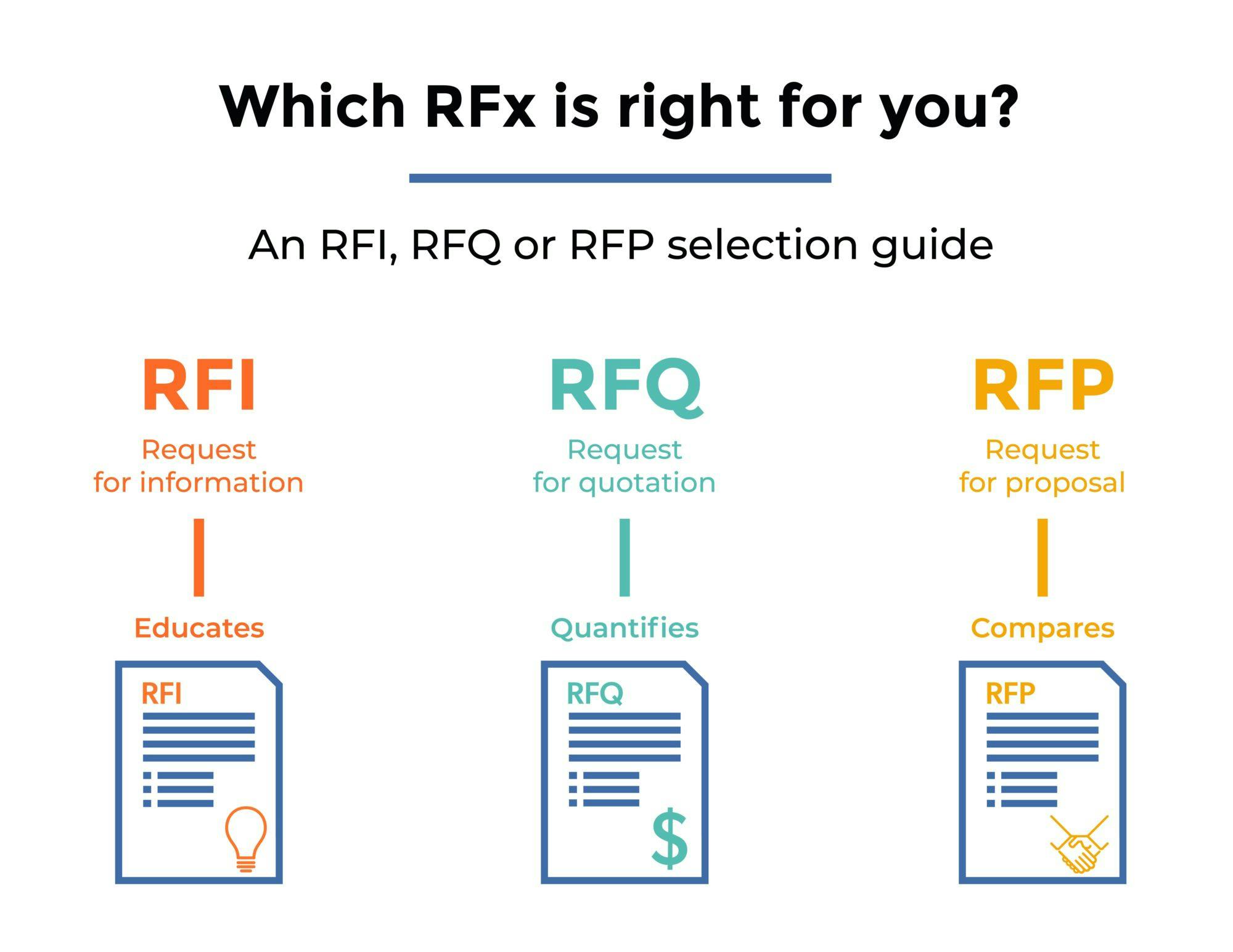
In a multi-step process, requests for information, requests for qualifications and vendor profiles all help narrow down the list of vendors. They are shorter documents, so vendors are typically happy to respond. Working from the results, you can create a shortlist for your RFP. Consequently, because you’ve already gathered basic information, your RFP is now more focused and direct. It’s a win-win.
In The future of RFPs ebook, David Kutcher, founder of Confluence Forms and the RFP Database discusses the benefits of a multi-tier process saying:
“I’ve been seeing organizations get really smart by using an advised, multi-tier RFP process. They use requests for qualifications and requests for information to create a shortlist of providers before it even goes to the RFP. That way you’re limiting the full RFP process to a final five or ten vendors. This enables the organization that initiated the RFP to actually review in depth. At the same time, it enables bidders to spend more time creating a quality proposal, because they know that they’re already on a shortlist, as opposed to a cattle call.”
4. Be as transparent as possible
One of the things that frustrates RFP respondents most is unclear expectations. When you write the RFP, strive for transparency whenever possible. If you’re seeking to replace an incumbent vendor, provide that information as well as what areas are most likely to sway you. As RFP expert and consultant, Robin Davis noted in The future of RFPs ebook:
“In terms of those procurement teams or consultants writing RFPs, providing clear and concise goals and instructions is appreciated … Provide the background and information on what you currently have in place and the problems you are trying to solve. Then, in your questions, ask the vendor what they would do differently or better and what result they will deliver. In short, transparency is the way to go if you want the same in return.”
For more insights and advice from experts on how to prepare for long-term success, download the ebook: The future of RFPs.
Areas where transparency makes a big difference:
- Background and context: Provide as much information as you can about why you are seeking a solution. The better a vendor understands your current state, the more specific they can be about how they will help.
- Expected outcome and goals: While it’s important to be open to creativity, it’s also crucial to be clear about what you expect. With that in mind, provide clear expectations about your required timeline, deliverables and return on investment.
- Evaluation and scoring: Preparing proposals is time consuming. Therefore, when you write the RFP, include who will evaluate the proposal and how. This helps vendors spend their time wisely. In addition, if you’re using weighted scoring, provide the section weights. Defining your priorities ensures respondents spend time creating thoughtful answers to the questions that are most important to your organization.
5. Customize and optimize your template
Follow RFP template best practices and don’t get too comfortable with your standard RFP template. Another frustration that RFP respondents often mention is the confusion created when responding to an RFP that hasn’t been updated. Sending a template without customization often results in questions that are irrelevant, contradictory or confusing. When faced with these challenges, many vendors will simply opt not to invest the time and effort required to respond.
As you receive proposals, evaluate responses and select RFP winners, examine what works. The more RFP data you can collect from your process, the better. Certainly it’s important to take time once or twice a year to optimize your process and templates. Examine how you write RFPs. Are your templates working? Are there questions that are now out of date? What questions do you often answer from vendors and can you proactively provide that information? As with any business process, success and efficiency come from reflection and continual optimization.
Sample RFP templates and examples
Now, if you read the tips above and thought, ‘That’s great, but I still don’t know where to go from here,’ don’t fret. The internet is full of helpful samples and examples that demonstrate how to write an RFP. But here are our favorite.
Best RFP template for general use
This helpful template gives you an appealing format and sample sections to start from. As you write your RFP, this template provides examples and instructions.
Download the template
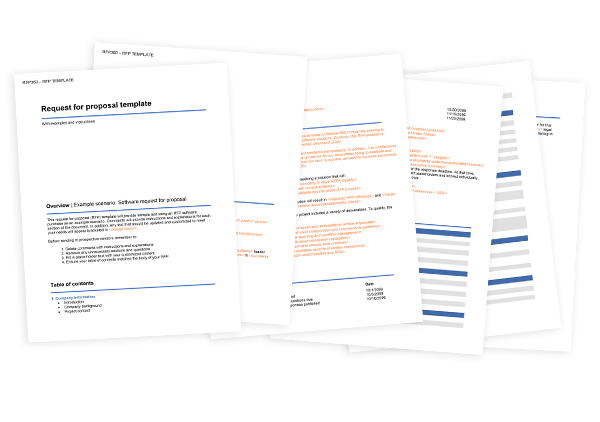
Additional sample RFP templates for you to customize:
- Chartered Institute of Procurement and Supply template
- Hubspot’s suggested RFP templates
- PandaDoc template library
- Template Lab sample RFPs
The best RFP examples – By industry
Often, you may be asked to write an RFP for an item, product or service you don’t know much about. It can be intimidating, but fortunately there are plenty of real-world examples available online. To help, we’ve gathered the most searched RFPs in one place.
33 of the best RFP examples: Explore sample RFPs by industry
Tools for writing RFPs: Resources and RFP software
Resources for writing RFPs
The RFP process guide ebook
Mentioned above, this ebook explores in detail the entire RFP process. From beginning to end, everything you need to know is included.
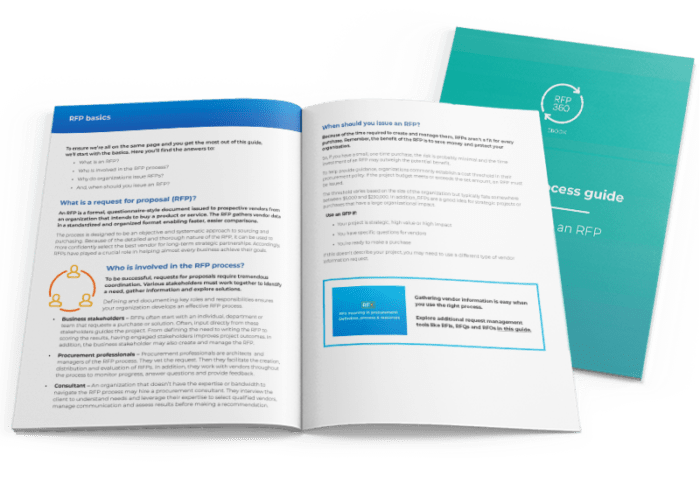
The Chartered Institute of Procurement & Supply (CIPS)
CIPS is a global non-profit organization dedicated to all things procurement and supply chain related. They have a wealth of resources and information both for members and non-members.
Institute for Supply Management (ISM)
Offering certification and training, ISM is another great resource for professional development and procurement best practices. From blogs to conferences and everything in between, ISM has it all.
How to write a request for proposal overview video from Professor Wolters
Another great video overview from Professor Mark Wolters. This quick 10-minute video offers a specific example and overview of how to write an RFP.
RFP software for automating RFPs
RFP software can help you more easily create and issue an RFP, as well as evaluate the resulting proposals.
We recommend looking for a solution that:
- Includes a knowledge library of centralized RFP data to use in future RFPs
- Allows users to collaborate at the same time, preventing version-control issues
- Tracks real time progress as vendors complete their proposals
- Empowers centralized communication between buyers and sellers eliminating back-and-forth emails
- Allows you to create and distribute effective security questionnaires
- Simplifies the scoring and evaluation process and automates weighted scoring
Ultimately, even if you’re not a procurement manager, knowing how to write a request for proposal is a valuable skill. Indeed, writing an RFP that is comprehensive and thoughtful requires some of the most sought after skills in business — big-picture thinking, attention to detail, collaboration and even emotional intelligence. So, even if you only need to issue one or two per year, taking the time to understand the process and importance of writing an RFP is well worth it.

